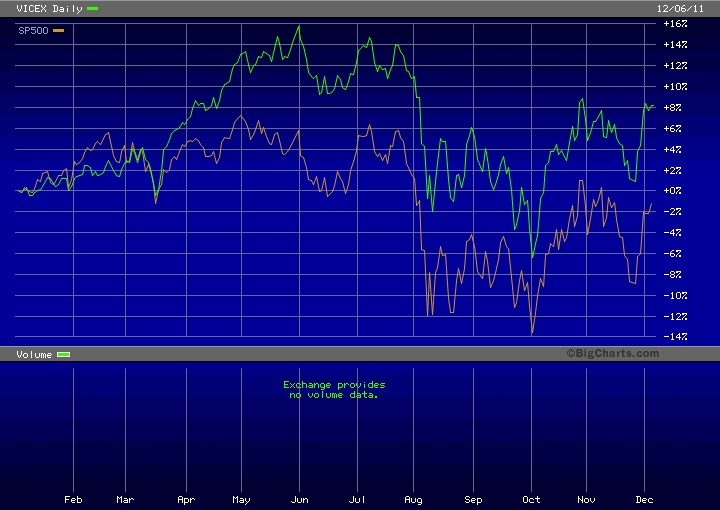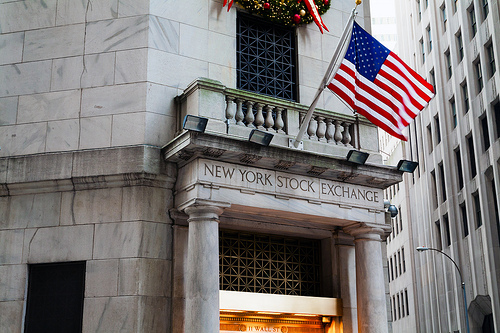 Author: Charles Sizemore
Author: Charles Sizemore
Covestor models: Sizemore Investment Letter and Tactical ETF
Disclosure: No position in VIG at time of writing
Risk on, risk off. No four words could better describe the frustrating year that was 2011. Yes, I realize that the year isn’t quite over yet. We still have a few more weeks. But I, for one, am ready for a fresh start in the New Year. We’ve done reasonably well in 2011, but it has been a lurching, nauseating roller coaster ride to get here, and we would have suffered a lot less heartburn had we simply taken the year off.
For those of us who consider ourselves value investors, the risk on/risk off trade is particularly frustrating because the market has made little distinction in 2011 between the wheat and the chaff. When the market is in “risk on” mode, everything tends to rise in lockstep with little regard for price or quality. And investors differentiate even less in “risk off” mode, throwing out the baby with the bathwater.
If you’ve gotten whipsawed a few times in 2011, don’t feel bad. Even some of the all-time investing greats have suffered an annus horribilis. George Soros, the godfather of hedge fund managers, struggled to turn a profit this year and closed his fund to outside investors. And Pimco’s Bill Gross — the Bond King himself — has had one of the worst years of his career, finding himself at the bottom of his peer group.
Still, not everything has performed poorly. Boring, consistent dividend-paying stocks have held up comparatively well, and “vice” stocks— particularly tobacco and some alcoholic beverage stocks — have had a phenomenal year. As a proxy, take a look at Figure 1, which compares the performance of the Vice Fund (VICEX) to the S&P 500 year to date.
Figure 1: VICEX vs. S&P 500 1/1/2011-12/6/2011 (source: BigCharts.com)

Vice has a 10 percentage point lead, in spite of the fund’s high allocation to gaming and defense stocks, which have not fared as well.
As investors, we’re not particularly interested in what performed well yesterday. We’re far more concerned with what will perform well tomorrow.
And there’s the rub. So long as we remain in this high-correlation, risk on/risk off market, our investment performance will be closely tied to shifting political winds in Europe.
If Europe’s leaders manage to reestablish confidence in their respective sovereign bond markets, then it’s “risk on” and commodities and lower quality, more speculative stocks should do phenomenally well. But if we have another setback — say, if a major piece of reform legislation gets torpedoed by squabbling among Euro nations, or a botched referendum — then it’s “risk off” and you’d better be in cash.
In honor of the movie release of Michael Lewis’s Moneyball, I’ll use a baseball analogy. You run the risk of swinging big and missing if you bet on “risk on” and we end up with “risk off.” But, if you bet on “risk off” and we end up with “risk on” you run the risk of getting a called strike as a potential home run pitch whizzes right by you.
In this environment of uncertainty, I recommend investing the way Billy Beane’s Oakland Athletics played baseball. Go for steady, consistent wins. You don’t have to hit home runs. Just get on base and avoid striking out.
In my view, this means implementing a dividend-focused strategy. Buy companies that survived the 2008 meltdown intact and actually raised their dividends that year. At current prices, your risk of long-term or permanent loss may be lessened. And if Europe’s economy blows up, you can be reasonably certain that your dividend checks won’t bounce.
For a good list of potential candidates, investors might want to take a look at the holdings of the Vanguard Dividend Appreciation ETF (NYSE:VIG). Every stock in the portfolio has raised its dividend for a minimum of 10 consecutive years — including the Armageddon years of 2008 and 2009.




